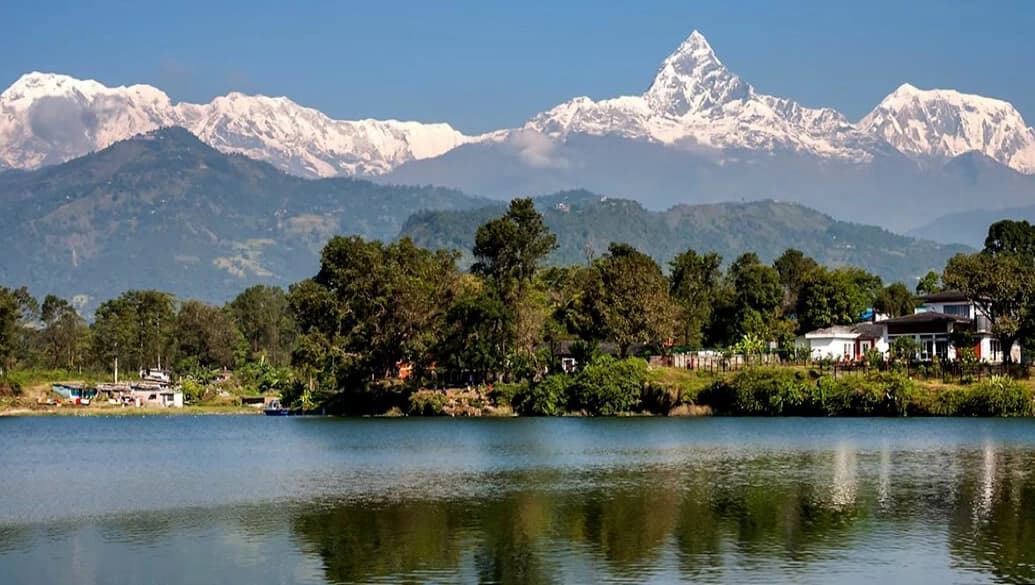You start the Pokhara day tour very early in the morning as you drive to Sarangkot view point to see the sunrise view over the Himalayas. Sarangkot sits in the formerly known VDC of Pokhara in Kaski district, which was later added in the main city of Pokhara. Sarangkot is an amazing hill station in Nepal, which sits 5km from the Lakeside of Pokhara. It is the major destination for tourists, as it presents the picturesque views of the major mountains of the Annapurna region like Annapurna massif (8,091 m), Machhapuchhre (6,993 m), and Dhaulagiri (8,167 m).
After visiting the Sarangkot View, you will return to your hotel to have breakfast and you visit the Bindhyabasini temple on the way back to Hotel. The Bindhyabasini temple is dedicated to Goddess Bhagwati. The Goddess is a popular deity known throughout Hinduism, and generally referred to as Shakti. The temple is considered as one of the main Shaktipiths of western Nepal. If some myths are believed, then people say that this temple is directly related to the Vindhyachal temple that is in Uttar Pradesh, India. The temple is clad in white and during Dashain, pilgrims flock the temple and offer animal tributes to their guardian deity. The temple is a popular hub for marriage ceremony and Bratabandha as well. There is a big tree in the temple premises, which provides a calm environment to meditate and relax.
After having breakfast at hotel, you will visit the Tal Barahi Temple. You will go to the Tal Bahari Temple by taking boating ride as the Tal Bahari is located in Small Island in the middle of the Phewa Lake. The exterior of the Tal Barahi Temple includes a two-story pagoda structure with a Gajur on top. The Gajur is gilded with gold whereas the other structure is made of stones, and the temple has a thatched roof. Tal Barahi Temple is dedicated to Goddess Durga: Protector of Gods. The only way to visit this temple is by boat. The temple is a great place to relax and observe the holy rituals being carried out.
After visiting the Tal Bahari Temple, you will drive to Peace Pagoda stupa. The Peace Pagoda in Pokhara is an example of serenity and bliss. The Pagoda is perched on top of a small hill and is wonderfully draped in white, symbolizing its purity and taintless nature. It overlooks the Annapurna Mountains and simultaneously reflects on the tranquil Fewa Lake below. Peace Pagoda is a great place for wanderers who are in a search of peace and silence. Tripadvisor has ranked Peace Pagoda as the second must visit site in the Pokhara valley. This further solidifies the claim that the Peace Pagoda is a place that should be visited. The premises of the pagoda is intentionally made silent so as to preserve its tranquility and to indulge visitors in the art of meditation.
After Tour of Peace pagoda, you will drive to Devi;s Falls. The Davis Falls is a small waterfall and there is nothing much enchanting or even appealing about the waterfall, except a few splashes here and there. To fully witness its splendor, one must visit it at the peak of monsoon. During that time, the water tears through the rocky slopes and disappears down an underground tunnel. The roaring noise of the rapids drowns the sound of humans and the splashing of the water demands either a raincoat or an umbrella. The high waters don’t stop tourists from treading close to the water but tread too close and you might drown in it.
After touring around the devi’s fall, you will visit the Gupteshwar Mahadev Cave. The Gupteshwor Mahadev Cave (known in the local tongue as Bhalu Dulo) is recognized as one of the longest caves in Nepal with a length that exceeds 2,000 meters. The cave sits across Davi's fall, and inside the cave, one can hear the thundering sound of water. As per the local beliefs, the cave was said to be discovered in the 16th century. During those times, there wasn’t any sort of modern-day decorations that you see today. The main entrance of the cave was only constructed in 1991 AD.
After visiting the Cave, you have one place left to visit to visit that is International mountain museum. The International mountain museum in Nepal was built with the help of the Nepal Mountaineering Association. Many international and national organizations, groups, and individuals have provided their relentless support to make the museum what it is today. The museum was cordially inaugurated on May 2002, by famous Everest summiteers: Ms. Junko Tabei from Japan and Appa Sherpa from Nepal. The museum spreads on an area of 12.6 acres with a display area of more than 4200 sq.mt. This museum was open to the public on 5 February 2014.
Nepal has a strong presence throughout the world for being the country that houses the highest peaks in the world, Mt. Everest (8848 m). Throughout history, many have ventured into this small Himalayan nation with the hope and aspiration to conquer this mighty peak. Not only Everest, but there are numerous other 8000 meter plus mountains as well. Some climbers were successful whereas some were not. This is the sad story of a life that not all who go to war win. The International Mountain Museum in Pokhara, tells the fable of the fellow climbers who had dared to conquer these peaks. The museum houses numerous artifacts and collage of pictures that depict life in the snowy regions of Nepal Himalayas.
After visiting the International mountain museum you will be dropped at your hotel in Pokhara and the day in Pokhara is complete.
Pokhara Day Tour Highlights
- View the Sunrise from Sarangkot.
- Visit Bindhyabasini temple.
- Visit Tal Barahi temple and Peace stupa.
- Visit Devi;s falls and Mahadev Cave.
- Visit International mountain museum.

